You don’t need us to tell you how tight budgets are for SMBs. You know how labour is often your biggest cost. But if you’re not actively tracking it? Ah. Well, that’s when things start to slip through the cracks.
Other than your income statements and cash flow reports, it’s important to have reports on the inner workings of your business, too – such as your operations, your staff, and your scheduling.
By building and monitoring reports on the likes of attendance, shift coverage, and labour costs, SMB owners and managers can use said data to:
- Back-up & make more informed decisions
- Make processes more efficient
- Save time on admin
- Improve job satisfaction for staff
- Stay compliant with labour regulations & keep an easier audit trail
- Have fewer overtime
- Cut costs without cutting corners
How?
With these five reports and trackable metrics, SMBs can feel they have hacker-level insights to improve how they operate behind the scenes. Who doesn’t wish to have that level of control?

Hours & costs reports
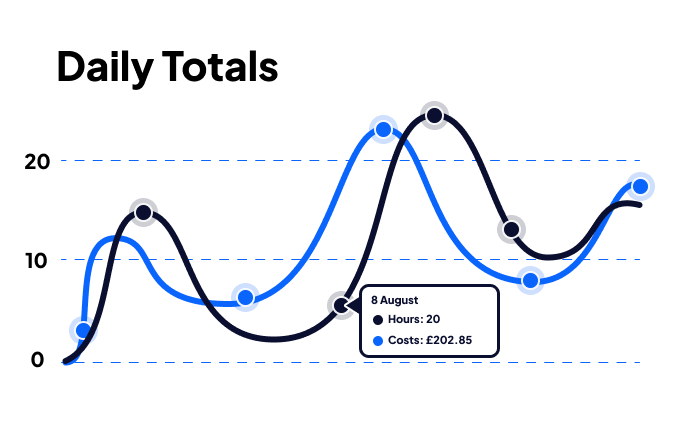
“Are we overspending on labour?”
“Which teams or roles are pushing us over budget?”
“Where are we racking up unnecessary overtime?”
Tracking your labour costs shows you exactly what you’re spending each day, week, and month – and where, from specific roles to sites and departments. This way, you can fine-tune your rotas, identify trends to fix inefficiencies and keep those labour costs under control.
You can see, in black and white (or in an utterly beautiful colour-coded display), how well your resources are being used by tracking actual costs compared to your budget in real-time. It helps you to schedule more accurately and adjust staffing levels where needed, greatly reducing your reliance on overtime and last-minute cover, and letting you cut spending without compromising on staff. Winner.
Simply by comparing your team’s scheduled vs. worked hours, you can:
- Reduce unnecessary overtime
- Monitor whether you’re on or over budget
- Improve payroll accuracy
- Help you forecast future staffing levels based on historical patterns
- Ensure staff aren’t being overworked
- Save on labour costs
“We can correlate staff hours with our busy periods, so from a cost management perspective, we can easily refine and predict what our needs are. Having this analytic capability has enhanced our efficiency and continues to help us schedule and manage our most expensive resource.” - Euan Noble, Founder & Commercial Director, Rokt
Shift reports
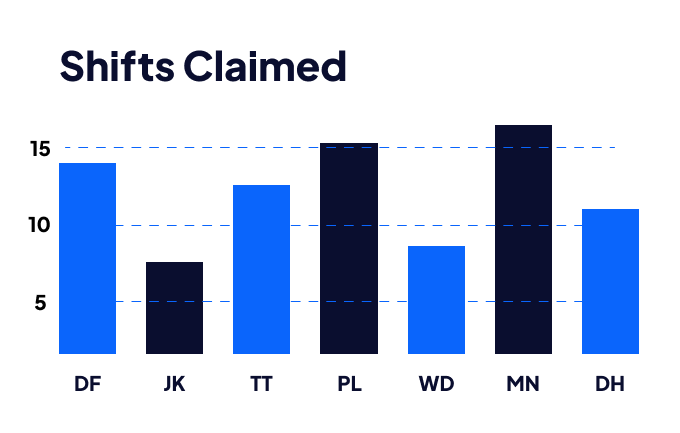
“Why do I keep needing last-minute cover?”
“Which shifts always get swapped or dropped?”
“Who’s always swapping out Friday nights?”
If your team works flexible or ever-changing schedules, shift reports are a must. They help you avoid scheduling clashes, cut down on last-minute changes, and keep a tidy record of it all in the process.
But what do you even track?
- Availability & unavailability
When shifts match availability, you get fewer no-shows and happier staff. What’s more, having so much data in one place and knowing what works for your team means you’ll likely find yourself with fewer errors and double bookings, leaving those cursed scheduling conflicts behind. - Shift swaps
By tracking which employees swap shifts, you get an idea of what shifts work best for them – and vice versa with who they’ve swapped with – which ultimately reduces your admin time for when you’re next scheduling. - Claiming shifts
If you offer certain shifts that staff can pick up, you might even track claimed vs. unclaimed shifts to identify patterns for which shifts are undesirable, as well as members of staff looking for extra hours.
You may not have even thought to track these, but they’re extremely beneficial. Using employee scheduling software with detailed shift reports allows SMBs to build tighter rotas faster, reduce scheduling conflicts, and improve staff morale. Winner.
“I can show that my service is flexible to meet the needs of the clients we’re supporting. We’ve got that audit history of what the shift was, who’s created it, who’s picked it up, who may have swapped it. All of those give us a good audit trail that works towards our quality assurance, knowing that we’ve got the right people in the right places at the right time.” - Nicola Johnson, Manager, Kelso Care
Reports for time off & cover
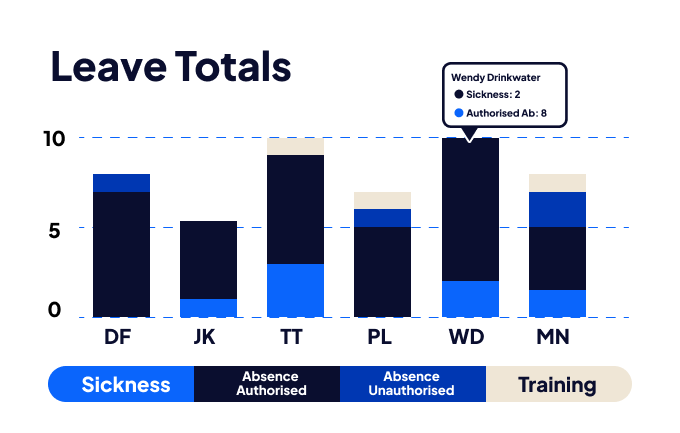
“Are people taking more sick days than usual lately?”
“Why am I always short-staffed on certain days/weeks/months?”
“Is anyone close to carrying over too much holiday?”
Time off management reports help small-to-medium businesses like yours plan leave around your busiest times without the last-minute panic for cover.
But it isn’t just about smooth operations (as great as that is). It also improves staff well-being and engagement.
With reports on time off and cover, owners and managers can:
- Avoid understaffing
Easily track employee holiday usage, sick leave, and time-off patterns. - Avoid overlapping holidays and an unbalanced workforce
With historical data in hand, you’ll spot when popular holiday weeks clash and overlap with your busiest seasons. You can then block out high-demand periods or set up a limit for leave requests so you’ll never find yourself understaffed and/or hiring costly, temporary staff. - Monitor staff’s remaining balances
Time off management reports show exactly how much leave your team has used and what they have left. It means you can be transparent with them – and that benefits everyone. Encouraging them to book time off, too, improves their well-being and minimises those pesky carryovers.
“Where we would usually manually work out costs, holidays, and attendance, RotaCloud already has all this information ready within seconds and allows a much deeper and better understanding of our costs.” - Matt Black, General Manager, Fibre
Attendance and absence reports
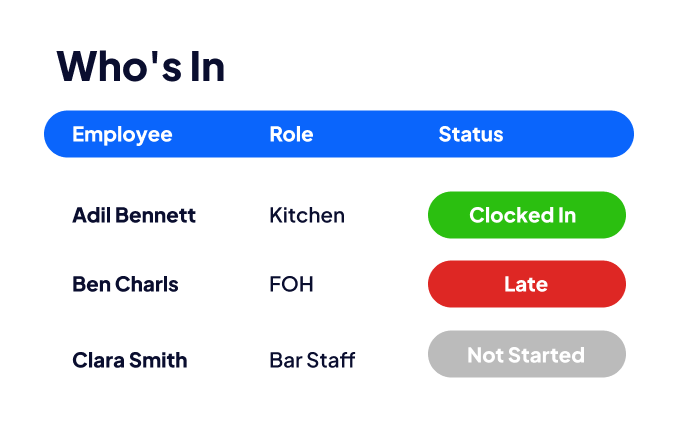
“Which team members are regularly late or calling in sick?”
“Are absences spiking at certain times of year?”
“Am I paying for time people aren’t actually working?”
Tracking absences is crucial for SMBs, and keeping records is even more so. Not tracking absences? That’s a lot of chaos, especially if you’re without attendance records to fall back on. Staff attendance tracking software uses automatic timesheets to help you maintain accurate data and minimise admin time. But attendance reports? They do this and more.
Attendance reports make it simple to spot patterns and deal with problems before they, well, become problems. That way, any concerns can be addressed before potentially becoming a greater issue – and, eventually, avoided entirely. Imagine that…
With attendance reports, you can:
- Monitor and keep a record of late starts, missed shifts, sickness, and Bradford Factor
- Set thresholds so that, once staff hit them, concerning absence is easily noticed and flagged
- Nip those recurring absences in the bud before they happen
- Stop the manual data entry by having digital timesheets automatically feed into reports
- Save costs overall by avoiding last-minute cover for missed shifts and payroll issues on Wage Day
- Use data as evidence (instead of anecdotal word of mouth) if it ever comes to disciplinary meetings
- See how specific employees’ attendance improves over time
“I know now that, if I look at one person’s rota and I look at their absence record for example, or their time management record, I know that it’s fully up to date. If there’s an issue there, I can fairly administer our procedures for it.” - Darren Longworth, Human Resources Business Partner, clothes2Order
Payroll reports
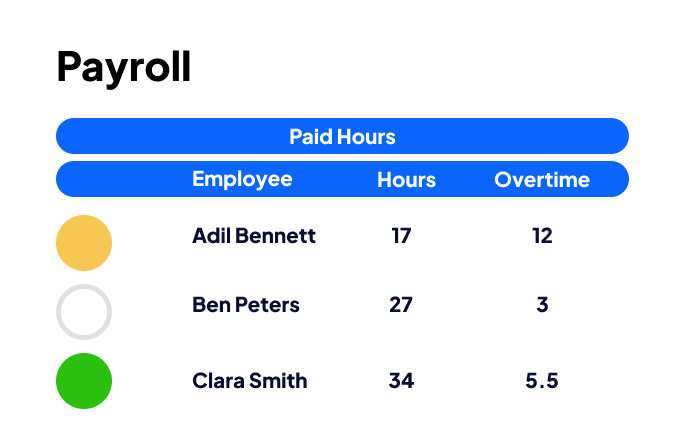
We’ll end with the obvious. While you may already have and use payroll reports, combining all of the above reports can truly ease the payroll pain and improve its accuracy.
If you don’t have automated timesheets yet, you’re likely spending too much time comparing timesheets to rotas and making payroll far (far, far, FAR) harder than it needs to be. So, this is when existing reports you have come in handy.
Payroll takes minutes when you have:
- Your staff’s actual worked hours that you’ve tracked (thank you, attendance reports)
- A detailed breakdown of hours, including paid leave and late clock-ins
- Completely painless (and automatic) calculations for your team’s total pay
Then, it’s just a matter of sending it to your accountant or using your payroll software provider. Job done.
"The information is accessible to us in payroll straight away, which is an absolute godsend. Being able to see instantly where someone is working, what shift they've actually done, the clock-in and clock-out records are just - it's made our payroll side so much more streamlined to what it was beforehand." - Emma Hobbs, Payroll Officer, Imagine, Act and Succeed
Wrap-up
Every hour, every shift, and every member of staff counts when you’re running a small-to medium-sized business. But you don’t need complicated systems to start understanding your business better. Just a few simple reports like hours worked, absences or leave balances can make all the difference to your day-to-day.
That’s where rota and workforce management software come in.
With the right tools, your reports update themselves. With zero manual data entry or calculations. What are you left with? More accurate payroll, lower costs, and reduced admin time.
Online rota software
Reclaim your workday with RotaCloud
RotaCloud combines rota planning, absence management, and one-click reports into one place, saving up to 170 hours of admin a year.
- 30-day free trial
- No card required
Read next >

The true cost of 'free' rota spreadsheets
Your spreadsheets may be digital, but they end up costing you more than a system built for workforce management – even free ones. Learn more about the true cost of your Excel spreadsheets.

